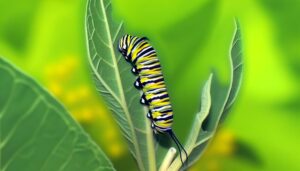Protecting and Celebrating the Significance of the Monarch Butterfly
The monarch butterfly plays a pivotal role in ecosystems as a significant pollinator, supporting plant reproduction and genetic diversity. It serves as a key prey species, contributing to ecological balance, and acts as a bioindicator of ecosystem health and climate changes.
Monarchs face numerous challenges, including habitat loss and climate shifts, affecting their complex migration cycle and reproductive success. Conservation efforts focus on habitat restoration and decreasing pesticide use to sustain their populations.
Their sensitive ecological role and the hurdles they encounter underscore their importance in maintaining biodiversity and ecosystem stability. Continuation will reveal further detail on these critical aspects.
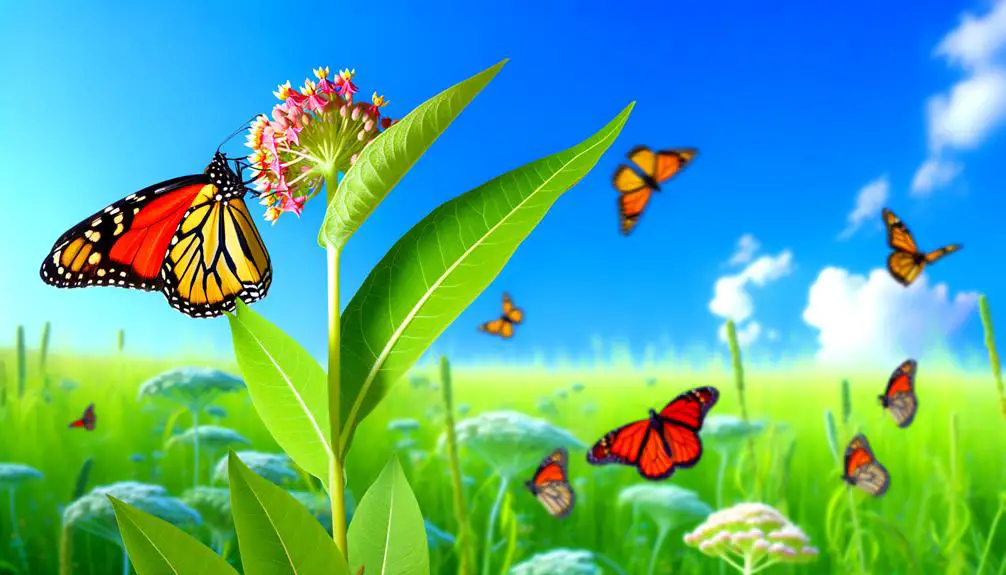
Key Takeaways
- Monarchs are vital pollinators, enhancing plant reproduction and genetic diversity.
- Their migration journey provides insights into climate change and habitat connectivity.
- Monarchs serve as bioindicators, reflecting ecosystem health and biodiversity changes.
- Habitat loss, especially milkweed decline, poses significant challenges to their survival.
Ecological Role
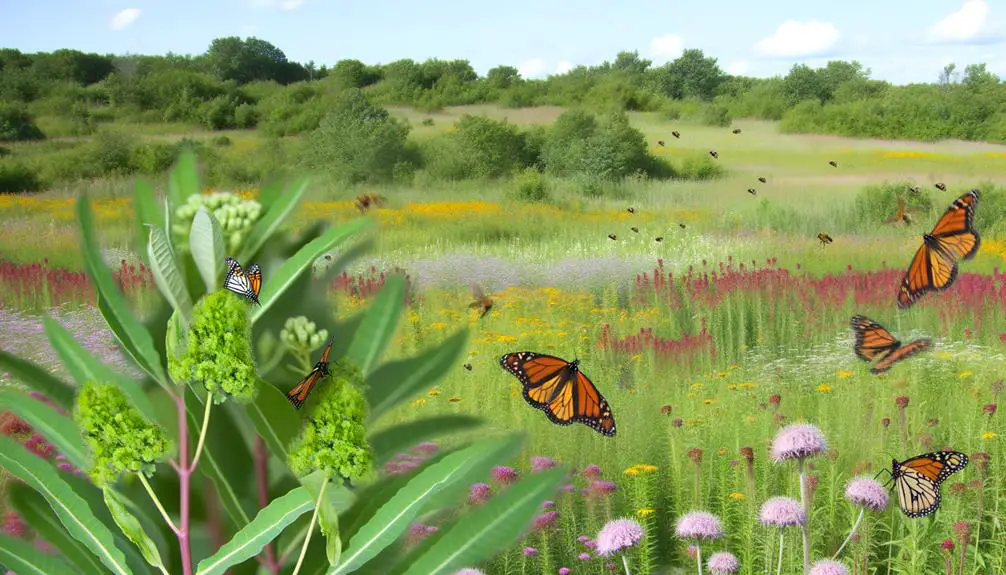
The monarch butterfly (Danaus plexippus) plays an essential ecological role as both a pollinator and a component of the food web in various ecosystems.
As pollinators, they contribute to the reproductive success of numerous flowering plants, thereby supporting biodiversity and ecosystem resilience. Their larval stage, feeding exclusively on milkweed, makes them significant in controlling milkweed population dynamics.
Additionally, monarchs serve as prey for a variety of predators, including birds, spiders, and insects, thereby transferring energy through the food web. Their presence indicates a healthy environment, as they are sensitive to habitat changes and pollutants.
Understanding and preserving the ecological functions of monarch butterflies is critical for maintaining the equilibrium and health of ecosystems where they thrive.
Migration Journey
Beginning one of the most remarkable migratory phenomena in the animal kingdom, monarch butterflies travel thousands of miles between their breeding grounds in North America and their overwintering sites in central Mexico.
This journey, spanning up to 3,000 miles, is facilitated by environmental cues such as temperature changes and daylight duration. Monarchs utilize a combination of genetic programming and environmental signals to navigate, often across multiple generations.
The migration is characterized by a southward movement in autumn, followed by a northward return in spring. During the migration, monarchs face numerous challenges, including habitat loss, climate change, and predation.
Understanding the intricacies of this migration is essential for conservation efforts aimed at preserving this iconic species and its migratory patterns.
Pollination Impact
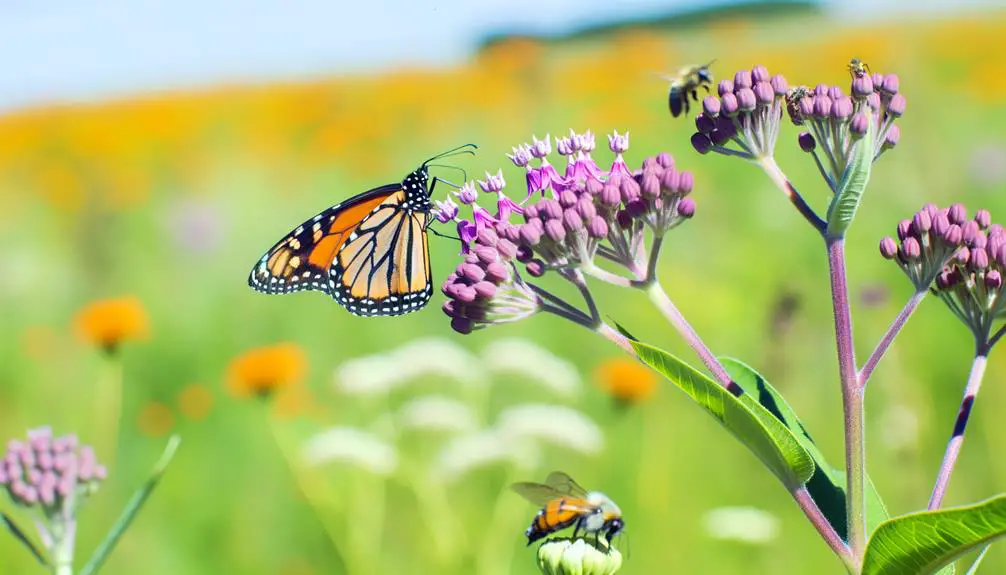
The pollination activities of Monarch butterflies play an essential ecological role by facilitating plant reproduction and ensuring the propagation of various flowering species.
This interaction not only supports the genetic diversity of plants but also enhances biodiversity within ecosystems.
Understanding the Monarch's contributions to these processes underscores their importance in maintaining ecological balance and resilience.
Ecological Role Explained
Monarch butterflies play an important role in pollination, contributing to the reproductive success of various flowering plants and maintaining ecosystem biodiversity.
Their migratory patterns facilitate the cross-pollination of numerous plant species across vast geographic ranges. As they feed on nectar, monarchs inadvertently transfer pollen from one flower to another, thereby aiding in genetic diversity and resilience of plant populations.
This pollination process is essential in supporting food webs, as it guarantees the availability of seeds and fruits that sustain a wide array of wildlife.
The ecological impact of monarch butterflies extends beyond individual plant species, influencing overall habitat health and stability, making their conservation critical for preserving ecological balance and biodiversity.
Plant Reproduction Benefits
Pollination by monarch butterflies considerably enhances plant reproductive success by enabling cross-fertilization, which increases genetic variability and adaptability within plant populations.
This process is essential for the resilience of plant species, as it fosters greater resistance to diseases, pests, and environmental changes.
Monarchs, through their migratory patterns, facilitate the transfer of pollen across vast distances, consequently contributing to the genetic diversity of flora in multiple regions.
Their role in pollination extends beyond mere pollen transfer; they contribute to the reproductive cycles of various angiosperms, ensuring the sustainability of entire ecosystems.
The enhanced genetic pool results in plants that are better equipped to thrive under diverse environmental conditions, thereby supporting ecological stability and productivity.
Biodiversity Enhancement Factors
Building upon the plant reproductive benefits, the monarch butterfly's pollination activities greatly enhance biodiversity by promoting genetic diversity among plant species, which in turn supports a variety of wildlife dependent on these plants.
This genetic diversity is vital for increasing ecosystem resilience, allowing plant populations to adapt to environmental changes and resist diseases.
Monarchs, by transferring pollen across diverse floral species, facilitate cross-pollination, which enhances genetic variation.
This, in turn, fosters robust plant communities that provide essential habitats and food resources for numerous organisms, including birds, mammals, and other insects.
Such interactions underscore the monarch's role in sustaining ecological balance, emphasizing the intricate web of life that hinges on their pollination activities.
Environmental Indicators
As bioindicators, monarch butterflies provide critical insights into the health of ecosystems, reflecting changes in environmental conditions and biodiversity. Their sensitivity to habitat alterations and pesticide use makes them valuable for monitoring ecological integrity. Monarchs' migratory patterns can signal shifts in climate and habitat connectivity, offering a barometer for environmental fluctuations. Additionally, their reliance on specific host plants, such as milkweed, highlights the importance of plant-insect interactions in sustaining ecological networks.
| Indicator | Significance | Observations |
|---|---|---|
| Population Trends | Ecosystem Health | Declines signal habitat loss or degradation |
| Migration Patterns | Climate and Connectivity | Disruptions indicate environmental changes |
| Host Plant Health | Plant-Insect Interactions | Availability affects monarch survival rates |
These indicators underscore the monarchs' role in ecological assessments.
Climate Change Effects

The effects of climate change on the monarch butterfly encompass alterations in temperature and precipitation patterns, which subsequently influence their migratory behavior, breeding cycles, and availability of critical resources.
Elevated temperatures can disrupt the synchronization of migration, potentially causing monarchs to arrive at breeding grounds too early or too late, thereby affecting reproductive success.
Precipitation changes impact the growth of milkweed, the sole food source for larvae, and flowering plants that supply nectar for adults.
Additionally, extreme weather events, such as unseasonal storms, can devastate overwintering sites.
These fluctuations necessitate adaptive responses from monarch populations, which may involve shifts in migratory routes or timing, ultimately challenging their survival and the intricate ecological networks they support.
Habitat Challenges
The monarch butterfly faces significant habitat challenges primarily due to the loss of milkweed, which is essential for its reproduction and larval development.
Additionally, the impacts of climate change exacerbate these issues by altering migration patterns and the availability of suitable breeding grounds.
These combined factors threaten the survival and sustainability of monarch populations across their migratory range.
Loss of Milkweed
Milkweed, the sole larval host plant for monarch butterflies, faces significant declines due to agricultural practices and urban development.
The proliferation of herbicide-resistant crops has led to increased herbicide use, which indiscriminately eradicates milkweed from agricultural landscapes. Additionally, urban expansion reduces natural habitats, further diminishing milkweed availability.
This decline directly impacts monarch populations, as the butterflies rely exclusively on milkweed for larval development. Scientific studies indicate that the reduction of milkweed correlates with decreased monarch breeding success, highlighting the essential nature of this plant in the butterfly's life cycle.
Conservation efforts must prioritize the restoration and protection of milkweed habitats to support monarch survival, thereby preserving a crucial component of biodiversity and ecological health.
Climate Change Impact
Rising global temperatures and shifting precipitation patterns, driven by climate change, exacerbate habitat challenges for monarch butterflies. These climatic changes disrupt the delicate balance of their migratory and breeding cycles, leading to significant declines in population numbers. The table below outlines the key impacts of climate change on monarch habitats.
| Climate Factor | Impact on Monarch Habitat |
|---|---|
| Temperature Increases | Alters breeding grounds and migration patterns |
| Changes in Precipitation | Affects availability of milkweed and nectar |
| Extreme Weather Events | Destroys overwintering sites in Mexico |
| Habitat Fragmentation | Reduces connectivity between breeding sites |
The resulting habitat fragmentation and increased frequency of extreme weather events further threaten the survival of this iconic species, underscoring the urgent need for conservation efforts.
Conservation Efforts
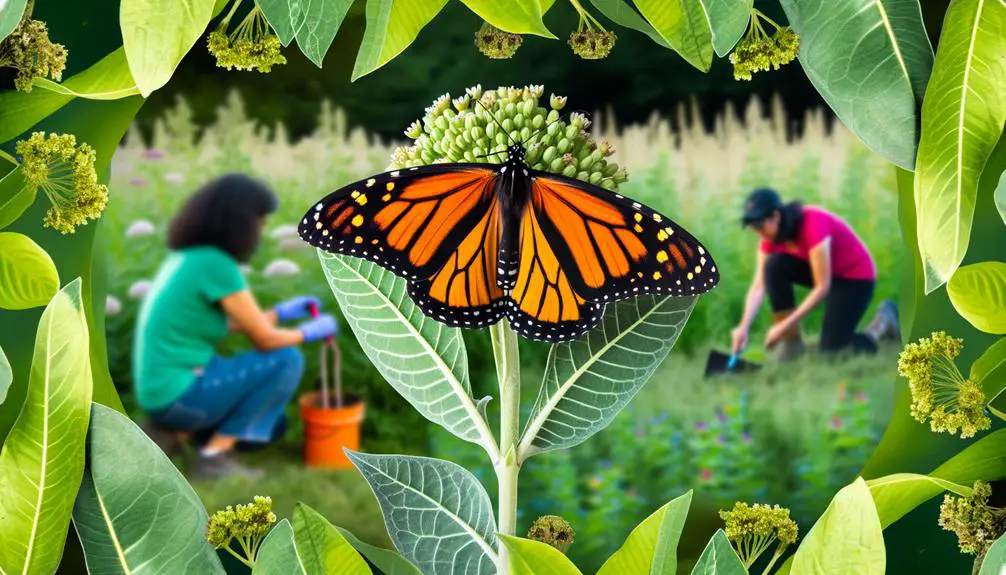
Conservation efforts for the monarch butterfly are essential due to its declining population, which has been greatly impacted by habitat loss, climate change, and pesticide use. These efforts are multi-faceted and require a collective approach to reverse the trend.
Key conservation strategies include:
- Habitat Restoration: Planting milkweed and nectar plants critical for monarch breeding and migration.
- Climate Change Mitigation: Reducing greenhouse gas emissions to maintain suitable habitats.
- Pesticide Regulation: Limiting the use of harmful pesticides that threaten monarch larvae and adults.
Conclusion
Ironically, the monarch butterfly, often perceived as merely a delicate emblem of nature's beauty, serves as a vital ecological linchpin.
Its extensive migratory journey not only underscores its resilience but also highlights its indispensable role in pollination.
Acting as a sentinel species, the monarch reflects broader environmental health, starkly illustrating climate change impacts and habitat degradation.
Conservation efforts, consequently, become not just a moral obligation but a scientific necessity to sustain this keystone species and, by extension, ecological balance.






